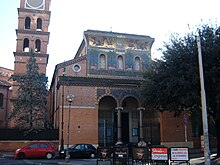Santa Maria Addolorata a piazza Buenos Aires
| Santa Maria Addolorata a piazza Buenos Aires Sorrowful Blessed Virgin Mary at Piazza Buenos Aires (in English) Beata Mariæ Perdolentis ad forum Bonærense (in Latin) |
|
|---|---|

Santa Maria Addolorata a piazza Buenos Aires
|
|
| Basic information | |
| Location |
|
| Affiliation | Roman Catholic |
| District | Lazio |
| Province | Rome |
| Country | Italy |
| Year consecrated | 1930 |
| Ecclesiastical or organizational status | Titular church |
| Leadership | Estanislao Esteban Karlic |
| Architectural description | |
| Architect(s) | Giuseppe Astorri |
| Architectural type | Church |
| Architectural style | Neo-roman;Neo-byzantine |
| Groundbreaking | 1910 |
| Completed | 1930 |
Santa Maria Addolorata a Piazza Buenos Aires (English: Our Lady of Sorrows at Piazza Buenos Aires), titular church and the Argentine national church, on Viale Regina Margherita, Rome.
It was founded by the Argentine priest Msgr. José León Gallardo with donations from the Argentine bishops, with the first stone being laid on 9 July 1910, the centenary of Argentine independence. Mrs. Saenz Peña, wife of the President of the Republic of Argentina, was present at the ceremony. Construction took twenty years, and the church was finally inaugurated in 1930. From then until 1989, the church was served by Mercedarian fathers; it is now served by Argentine diocesan clergy from a community in an adjoining house.
It was built by the architect Giuseppe Astorri with a 7-storey campanile and a 2-storey façade in the style of ancient Christian architecture, with a central depiction of the Lamb and symbols of the four Evangelists. The interior is also in ancient, Roman-Byzantine style, with a nave and two aisles divided by Ionic columns, a Cosmatesque-style pulpit and lectern and a polychrome marble floor (laid in geometric patterns with the national coat of arms of Argentina in the centre, and a memorial slab to its founder, which was presented by the Argentine cardinals and bishops at the Second Vatican Council).
In the apse at the east end is a mosaic of Our Lady of Sorrows by Giambattista Conti and a high altar decorated with onyx and covered by a baldachino supported by four granite Corinthian columns. The choir is separated from the nave by an altar ring of white marble which includes intaglia and bronze gates with the national coat-of-arms and the arms of the Order of the Mercedarians.
...
Wikipedia
